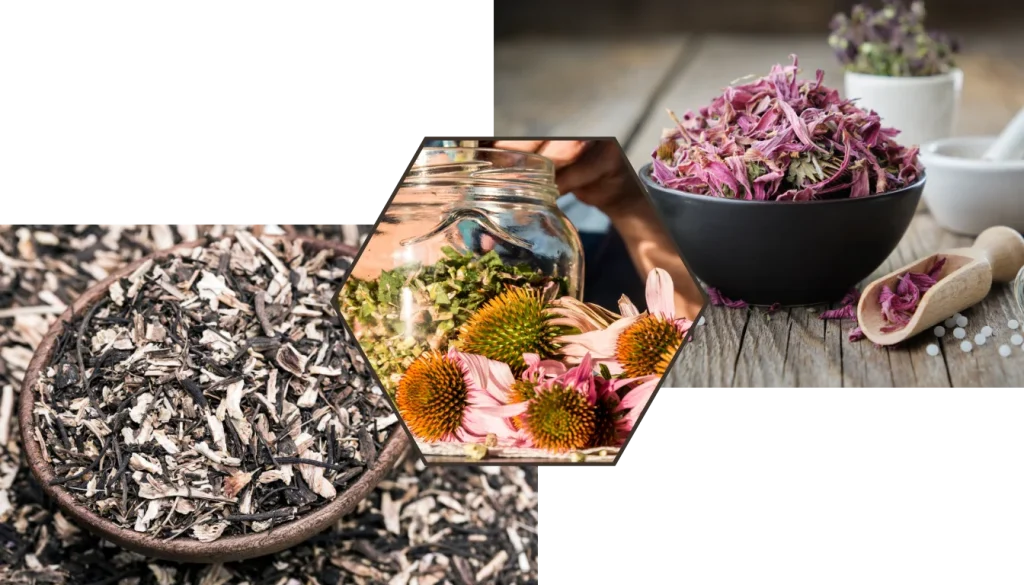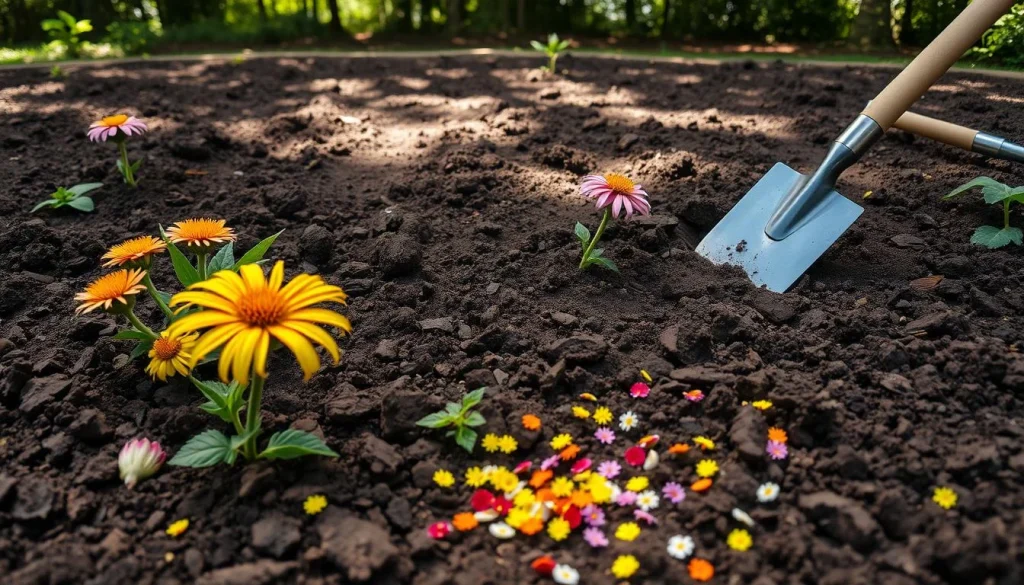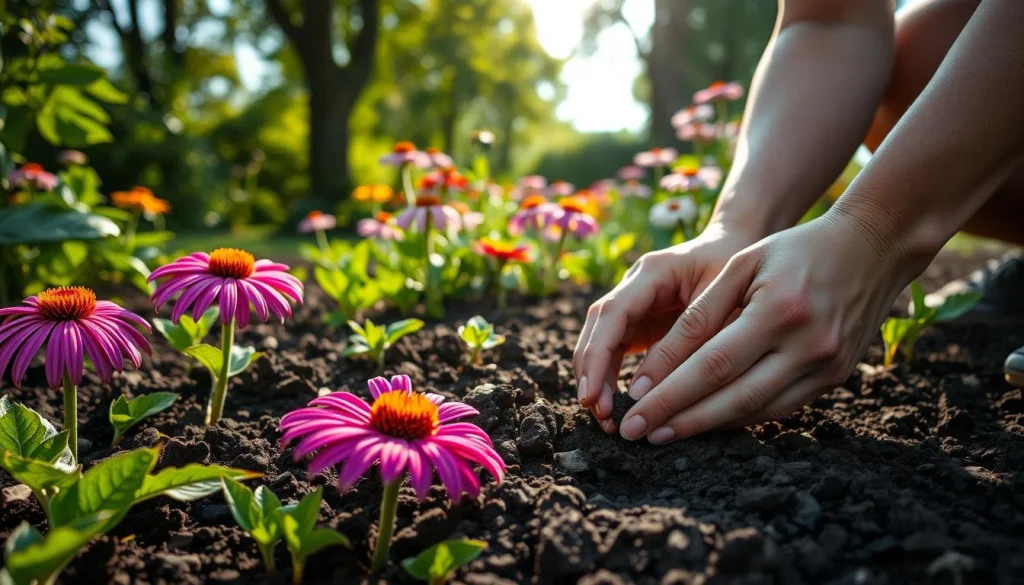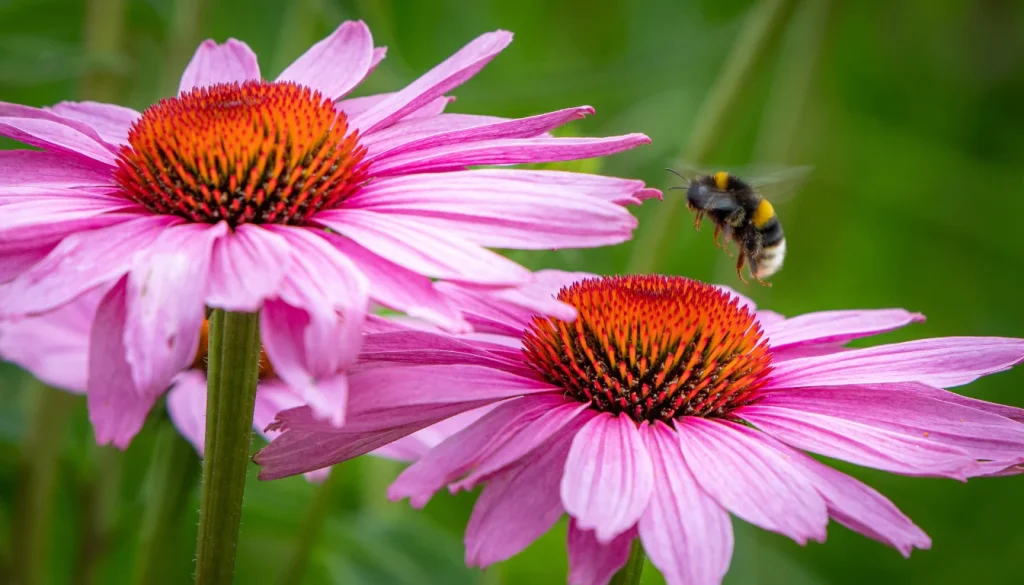Echinacea, or coneflower, is a favorite perennial for its bright flowers and health benefits. Growing echinacea from seed is rewarding and saves money. With the right steps, you can grow healthy echinacea plants that bloom for years.
This guide will help you growing echinacea from seed. You’ll learn about choosing seeds, planting, and caring for them. Whether you’re new to gardening or experienced, this article will help you grow beautiful echinacea plants.
Key Takeaways
- Choose high-quality echinacea seeds from reputable sources for best results.
- Provide echinacea with well-draining soil and full sun to partial shade.
- Sow echinacea seeds in spring or fall, depending on your climate and growing conditions.
- Keep soil consistently moist but not soggy during germination and seedling growth.
- Thin out seedlings to allow for proper spacing and airflow between mature plants.
- Monitor for common pests and diseases, taking prompt action to prevent damage.
Table of Contents
Introduction to Echinacea
Echinacea, also known as coneflowers, are vibrant and versatile plants. They are loved by gardeners and herbalists. These plants are not just beautiful but also have medicinal properties.
Native to North America, echinacea plants have been used for centuries. The most common species are Echinacea purpurea, Echinacea angustifolia, and Echinacea pallida. Each has its own unique benefits.
Echinacea plants are easy to grow and maintain. They do well in well-draining soil and full sun to partial shade. Their sturdy stems and long-lasting blooms add color to gardens from summer to fall.
Echinacea plants are also known for their medicinal properties. The roots, leaves, and flowers contain compounds that support the immune system. They can also help with cold and flu symptoms and promote overall well-being. Here are some key benefits of echinacea:
- Boosts immune function
- Reduces inflammation
- Alleviates upper respiratory symptoms
- Promotes wound healing
- Offers antioxidant properties
Whether you grow echinacea for its beauty or medicinal value, it’s a great choice. With the right care, you can enjoy its beauty and benefits for years.
| Echinacea Species | Flower Color | Height |
|---|---|---|
| Echinacea purpurea | Pink, purple | 2-4 feet |
| Echinacea angustifolia | Pink, purple | 1-2 feet |
| Echinacea pallida | Pale pink, white | 2-3 feet |
Benefits of Growing Echinacea
Growing echinacea plants is great for your health and garden. This herb is valued for its healing powers and beauty. Let’s look at why you should grow echinacea in your backyard.
Medicinal Properties
Echinacea boosts your immune system. It has compounds like polysaccharides and alkylamides that help your body fight off sickness. Drinking echinacea tea can make colds and flu less severe and shorter.
Echinacea also has other benefits:
- It fights inflammation
- It has antiviral and antibacterial effects
- It helps with upper respiratory infections
- It aids in wound healing

A vibrant and lush garden scene featuring blooming echinacea flowers in various colors, surrounded by a tranquil herbal apothecary setting. Soft sunlight filters through the leaves, illuminating a small wooden table adorned with glass jars filled with echinacea tinctures and dried petals. Delicate butterflies flutter around, and a gentle breeze sways the flowers, evoking a sense of natural healing and serenity.
You can use the leaves, flowers, and roots of echinacea plants. Dry them to make teas, tinctures, or supplements. This way, you can enjoy echinacea’s health benefits all year.
Ornamental Value
Echinacea is also beautiful in gardens and landscapes. Its vibrant flowers in pink, purple, and white add color and interest.
Echinacea’s beauty goes beyond its flowers:
| Plant Part | Ornamental Features |
|---|---|
| Flowers | Large, daisy-like blooms with prominent cone-shaped centers |
| Foliage | Lush, green leaves that provide a backdrop for the flowers |
| Height | Tall, upright stems that add vertical interest to borders and beds |
| Attractiveness to Pollinators | Draws bees, butterflies, and other beneficial insects to the garden |
Adding echinacea to your garden makes it more beautiful. It also helps pollinators like bees and butterflies. Growing echinacea supports biodiversity and garden health.
Choosing the Right Echinacea Seeds
When growing echinacea from seed, picking the right varieties and quality seeds is key. There are many species and cultivars to choose from. Think about your growing conditions and what you want from your plants before you decide.

A vibrant display of various Echinacea flower varieties, showcasing a range of colors including purple, pink, white, and orange. Each flower exhibits distinct petal shapes and sizes, surrounded by lush green foliage. The background features a soft-focus garden setting under bright sunlight, highlighting the natural beauty and diversity of these unique plants.
Echinacea Species and Varieties
The most common echinacea species for medicine and beauty are:
- Echinacea purpurea (Purple Coneflower)
- Echinacea angustifolia (Narrow-leaved Coneflower)
- Echinacea pallida (Pale Purple Coneflower)
These species have many cultivars with different colors, sizes, and bloom times. Some favorites include:
| Variety | Species | Flower Color | Height |
|---|---|---|---|
| Magnus | E. purpurea | Purple-pink | 3-4 ft |
| White Swan | E. purpurea | White | 2-3 ft |
| Sunset | E. purpurea | Orange-red | 2-3 ft |
| Narrow-leaved | E. angustifolia | Purple-pink | 1-2 ft |
Seed Quality and Source
For the best results, buy echinacea seeds from trusted sellers. Look for seeds that are:
- Fresh (harvested recently)
- Properly cleaned and stored
- Labeled correctly
- Tested for germination
“Investing in high-quality echinacea seed is the first step to a successful and bountiful harvest.”
Think about sunlight, soil, and drainage when choosing where to grow echinacea. Most like full sun to partial shade and well-drained soil. By picking the right seeds and growing conditions, you’ll grow healthy, vibrant echinacea plants.
Get more information about Growing Crops:
- ????Grass Seed to Growing
- ????Growing Eucalyptus
- ????Garlic Growing
- ????Winter Garden Plant
Preparing the Planting Site
Choosing the right spot for your echinacea plants is key. Look for a place that gets full sun to partial shade. This is where echinacea grows best. Also, make sure the soil drains well to avoid root rot.
To get your planting bed ready, first remove weeds, rocks, and debris. Then, loosen the soil to about 12 inches deep. Use a garden fork or tiller for this. It helps the soil drain better and improves growth conditions for echinacea.

A vibrant garden plot being prepared for planting echinacea, with rich, dark soil being tilled, garden tools like a spade and rake nearby, patches of sunlight filtering through trees above, and a scattering of colorful wildflower seeds on the ground, showcasing the early stages of garden preparation.
Add organic matter like compost or well-rotted manure to the soil. This makes the soil more fertile and helps echinacea grow well. Below is a table showing the best soil amendments for echinacea:
| Soil Amendment | Amount per Square Foot | Benefits |
|---|---|---|
| Compost | 1-2 inches | Improves soil structure and fertility |
| Well-rotted manure | 1 inch | Provides nutrients and enhances soil quality |
| Perlite or vermiculite | 1/2 inch | Improves drainage and aeration |
After adding the amendments, rake the soil smooth. Level the bed for even planting. With a well-prepared site, your echinacea plants will thrive and bloom beautifully.
Sowing Echinacea Seeds
Sowing echinacea seeds at the right time and in the right conditions is crucial. They need cold stratification to grow. This can be done by planting in the fall or early spring.

A serene garden scene featuring a close-up of hands gently sowing echinacea seeds into rich, dark soil, surrounded by vibrant green foliage and soft sunlight filtering through trees, with a backdrop of colorful echinacea flowers blooming in various stages of growth.
For the best results, start echinacea seeds indoors 6-8 weeks before the last frost. Use trays or pots with a well-draining mix. Make sure the soil is moist before planting.
Timing and Conditions
Echinacea seeds germinate best at 65-75°F (18-24°C). Place them in a warm, bright spot but not in direct sunlight. Keep the soil moist but not too wet. Germination takes 10-20 days.
You can also sow seeds directly outdoors in the fall. This lets them stratify naturally over winter. Clear the area of weeds and debris. Rake the soil to make it even.
Planting Depth and Spacing
When planting echinacea seeds, the depth is important. Plant them 1/8 to 1/4 inch deep. This lets them get some light. Press the seeds into the soil gently.
Seed spacing varies depending on where you start them. Indoors, sow 2-3 seeds per cell. Once they have true leaves, keep only the strongest seedling.
For outdoor sowing, space seeds 12-18 inches apart. After they germinate, thin them to keep the right spacing. This lets the plants grow well.
“Patience is key when sowing echinacea seeds. With the right timing, conditions, and care, you’ll be rewarded with beautiful, resilient plants that will thrive in your garden for years to come.”
Caring for Echinacea Seedlings
After your echinacea seeds sprout, it’s crucial to care for the seedlings. Focus on watering, fertilizing, thinning, and transplanting. This will help your seedlings grow strong and healthy.
Watering and Moisture
Keeping the soil moist is important for echinacea seedlings. Make sure it’s not too wet, as this can harm the roots. Use a fine mist or a watering can with a rose attachment to water them gently.
As the seedlings get bigger, you can water them less often. This helps them develop deeper roots.
Fertilizing and Nutrition
Give your seedlings a light dose of balanced fertilizer every 2-3 weeks. Don’t overdo it, as too much fertilizer can hurt the roots. Use a half-strength solution to prevent damage and ensure they get the nutrients they need.
“Proper nutrition is essential for strong, resilient echinacea plants that can withstand environmental stresses and produce abundant blooms.” – Dr. Jane Smith, Horticulturist
Thinning and Transplanting
As the seedlings grow, you might need to thin them out. Wait until they have their first true leaves and then space them 6-8 inches apart. This helps them grow better by giving them more room and air.
When they’re 3-4 inches tall and have strong roots, it’s time to transplant them. Choose a spot with good drainage and lots of sunlight. Carefully dig them up, keeping as much root as possible, and plant them at the same depth. Water them well and provide shade if it’s very sunny.
Growing Echinacea in Pots
Want to brighten up your patio? Growing echinacea in pots is a great idea. Echinacea, or coneflower, is a hardy plant that does well in containers. With the right care, you can enjoy its beauty and health benefits.
Choose a pot that’s at least 12 inches deep and wide. This size fits the plant’s roots well. Make sure the pot has holes for drainage to avoid root rot. Use a potting mix that drains well, with compost or peat moss and perlite or vermiculite.
Echinacea loves full sun, so pick a spot with at least six hours of direct sunlight. But, if your area gets too hot in the afternoon, some shade can help. Water your echinacea often, but let the top inch of soil dry out before watering again.
Fertilize your echinacea every four to six weeks when it’s growing. Use a balanced fertilizer, either water-soluble or slow-release. Remove spent flowers to keep your plant looking good and blooming.
Here’s a quick guide for potted echinacea care:
| Care Aspect | Recommendation |
|---|---|
| Pot Size | 12 inches deep and wide (minimum) |
| Soil | Well-draining potting mix with organic matter |
| Sunlight | Full sun (6+ hours) or light afternoon shade |
| Watering | Keep soil moist but not soggy |
| Fertilizing | Every 4-6 weeks with balanced fertilizer |
| Deadheading | Remove spent flowers regularly |
By following these tips, you can make a vibrant container garden. It will attract pollinators and add beauty to your outdoor space.
Echinacea Growing Conditions
To make sure your echinacea plants do well, give them the best growing conditions. Echinacea is tough and can grow in many places. But knowing what it likes for sunlight, soil, and temperature will help it grow strong and bloom well.

Sunlight Requirements
Echinacea loves the sun and needs full sun to grow strong. Make sure it gets at least 6 hours of direct sunlight each day. It can handle some shade, but not too much, or it might not bloom as much. Pick a sunny spot for your echinacea to grow.
Soil Type and pH
Echinacea can grow in different soils but likes soil that drains well and is rich in organic matter. The best soil pH for echinacea is between 6.0 and 7.0. Don’t plant it in heavy clay or waterlogged soil, as it can cause root rot. If your soil is bad, add compost or well-rotted manure to make it better.
Temperature and Climate
Echinacea is a hardy perennial that can handle many temperatures. It grows well in USDA hardiness zones 3 to 9. It can handle frost and even benefits from cool weather to grow better next year. In hot places, it might need some shade in the afternoon to avoid getting too hot.
By giving your echinacea the right sunlight, soil, and temperature, you’ll help it thrive. It will give you beautiful flowers and strong medicine for many years.
Common Pests and Diseases
Echinacea plants are usually strong and healthy. But, they can still face pests and diseases. Knowing about these problems and how to prevent them can help your echinacea plants thrive.
Echinacea Pests
Some pests that might bother echinacea include:
- Aphids
- Spider mites
- Japanese beetles
- Leaf miners
Check your echinacea plants often for pests. Look for signs like discolored or twisted leaves. Using natural pest control and introducing helpful insects can keep pests away without harming the environment.
Echinacea Diseases
Echinacea plants can also get sick from fungi and bacteria. Some common diseases are:
- Powdery mildew
- Leaf spot
- Aster yellows
- Root rot
To avoid diseases, make sure plants have enough space. Don’t water from above and remove sick parts quickly. Good soil drainage and not overfertilizing also help prevent diseases.
Preventing Echinacea Problems
Preventing pests and diseases is crucial. Here are some ways to keep your echinacea plants healthy:
| Prevention Method | Benefits |
|---|---|
| Choose disease-resistant varieties | Reduces susceptibility to common issues |
| Practice crop rotation | Prevents buildup of soil-borne pathogens |
| Maintain proper plant spacing | Improves air circulation and reduces disease risk |
| Remove dead or infected plant material | Limits the spread of pests and diseases |
| Monitor plants regularly | Allows for early detection and intervention |
By being careful and quick to act, you can have a beautiful and healthy echinacea garden. This way, you’ll have fewer problems with pests and diseases.
Harvesting and Using Echinacea
After growing your echinacea plants, it’s time to harvest them. This process lets you enjoy the plant’s health benefits and beauty. You can easily collect the leaves, flowers, and roots for future use.
Harvesting Leaves, Flowers, and Roots
To get echinacea leaves, just cut them off with clean scissors. It’s best to do this before the plant flowers. This way, the leaves have more medicinal value.
Echinacea flowers are ready when they’re fully open and bright. Cut them off at the base, leaving a bit of stem. For the roots, you need to dig up the whole plant. Do this in the fall, after the plant has stopped flowering.
Drying and Storing Echinacea
To dry leaves and flowers, lay them out in a single layer. Do this in a dry, well-ventilated area away from sunlight. It might take a few days to a week for them to dry completely.
Once dry, put the leaves and flowers in airtight containers. Store them in a cool, dark place. For the roots, wash them well and chop them into small pieces. Dry them out completely before storing in airtight containers.
By following these steps, you can enjoy your echinacea for months. Use the leaves, flowers, or roots to make teas, tinctures, or other herbal remedies. You’ll get to enjoy your hard work and share echinacea with others.
FAQ
Can I grow echinacea from seed?
Yes, growing echinacea from seed is easy. Choose high-quality seeds from a trusted source. Follow the right planting and care steps for great results.
What are the benefits of growing echinacea?
Echinacea is good for your health and looks great in gardens. It boosts your immune system and is used in herbal remedies. Plus, its flowers attract pollinators and brighten up your garden.
How do I choose the right echinacea seeds?
Pick echinacea seeds based on the type you want. Look for seeds from a reliable seller for the best chance of success. Think about the plant’s size, flower color, and how well it grows in your area.
What are the ideal growing conditions for echinacea?
Echinacea loves full sun to partial shade and well-draining soil. It does best in slightly acidic to neutral soil and can handle many temperatures. Keep the soil moist and protect it from extreme weather.
How do I sow echinacea seeds?
You can sow echinacea seeds directly in the garden or indoors. Plant them 1/4 to 1/2 inch deep and keep the soil moist until they germinate. Thin the seedlings to give them enough room to grow.
Can I grow echinacea in pots?
Yes, you can grow echinacea in pots. Use a container with good drainage and fill it with a mix that drains well. Make sure the pot is big enough for the plant and water and fertilize regularly.
How do I harvest and use echinacea?
Harvest echinacea leaves, flowers, and roots as needed. Use leaves and flowers for tea or tinctures, and roots for herbal remedies in the fall. Always harvest correctly and store the plant material in a cool, dry place.

